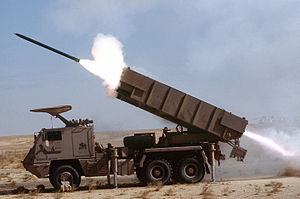Astros II MLRS
| ASTROS-II Multiple Launch Rocket System (MLRS) | |
|---|---|

ASTROS-II
|
|
| Type | Rocket artillery |
| Place of origin | Brazil |
| Service history | |
| In service | Since 1983 |
| Wars |
Iran–Iraq War Gulf War Angolan Civil War Military Intervention in Yemen |
| Production history | |
| Manufacturer | Avibras |
| No. built | at least 164 |
| Specifications | |
| Weight | 10,000 kg (22,046 lbs) |
| Length | 7 m (20 ft) |
| Width | 2.9 m (9 ft 6 in) |
| Height | 2.6 m (8 ft 6 in) |
| Crew | 3 |
|
|
|
| Cartridge | Rocket length: 4.20 m (13 ft 9 in) Rocket weight: 152 kg (335 lb) |
| Caliber | 180mm (7.08in) |
| Maximum firing range | 16,000m (17,500yds) |
|
|
|
|
Main
armament |
Launcher Loader Module |
|
Secondary
armament |
1 × 12.7 mm M2 Browning machine gun |
| Engine | Mercedes OM422 8-cylinder diesel 280 hp (209 kW) |
| Suspension | 6×6 |
|
Operational
range |
480 km (298 mi) |
| Speed | 90 Km/h (56 mph) |
ASTROS II (Artillery SaTuration ROcket System) is a self-propelled multiple rocket launcher produced in Brazil by the Avibras company. It features modular design and employs rockets with calibers ranging from 127 mm to 300 mm. It was developed on the basis of a Tectran VBT-2028 6×6 all-terrain vehicle for enhanced mobility.
Astros II are normally grouped in artillery batteries consisting on average of about 13 vehicles: 6 of them are Astros II launchers, 6 are rocket resupply trucks and 1 a special radar-equipped vehicle controlling the fire-control system. The launcher is capable of firing rockets of different calibres armed with a range of warheads.
Each rocket resupply truck carries up to two complete reloads.
The ASTROS II artillery system entered service with the Brazilian Army in 1983. The system is battle proven, having been used in action by the Iraqi Army in the Gulf Wars.
In the 1980s, Avibrás sold an estimated sixty-six Astros II artillery systems to Iraq. Iraq also built the Sajil-60 which is a license-built version of the Brazilian SS-60. Sixty Astros II were sold to Saudi Arabia and an unspecified number sold to Bahrain and Qatar. Total sales of the Astros II between 1982 and 1987 reached US$1 billion. This fact made the Astros II multiple rocket launcher the most profitable weapon produced by Avibrás.
In the 1980s and early 1990s, Avibrás worked almost exclusively with the manufacturing of rockets and multiple-launch rocket systems (MLRS), such as the Astros II, in addition to developing antitank and antiship missiles. At its peak, Avibrás employed 6,000 people; later it would be reduced to 900 people in the early 1990s as the arms industry demand fell. Even so, in the first Gulf War in 1991, the Astros II was successfully used by Saudi Arabia against Iraq. Years earlier, the Astros II system helped Angola to defeat the UNITA.
The next step is an ambitious program, the Astros in 2020. Being a new concept, it will require an estimated investment of R$ 1.2 billion, of which about US$210 million will be invested solely in development. It will be integrated with the cruise missile AVMT-300 with 300-km range during the stage of testing and certification. It is said that the venture will, for example, enable the Army to integrate the Astros with defense anti-aircraft guns, paving the way for the utilization of common platforms, trucks, parts of electronic sensors and command vehicles. The Astros 2020 will also be equipped with a 180 mm GPS-guided rocket called the SS-AV-40 with a range of 40 km (25 mi). 30 Astros 2020 systems are to be acquired.
...
Wikipedia
